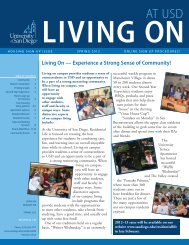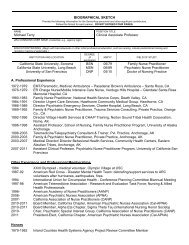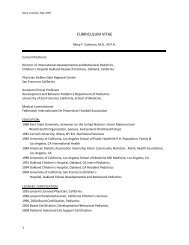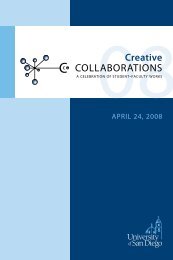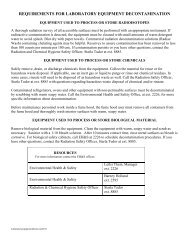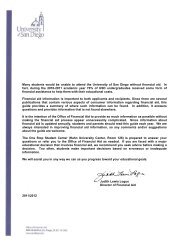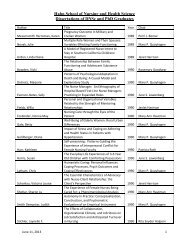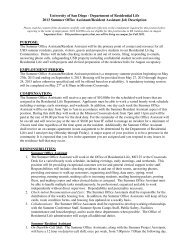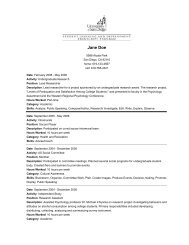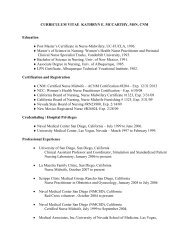Kevin Cole - University of San Diego
Kevin Cole - University of San Diego
Kevin Cole - University of San Diego
Create successful ePaper yourself
Turn your PDF publications into a flip-book with our unique Google optimized e-Paper software.
The point <strong>of</strong> this argument was that<br />
package licenses do not present the same<br />
foreclosure risk as ties between products.<br />
Philips was right about that, but the argument<br />
needs another step. If the package<br />
forced licensees to spend more than they<br />
would if they had to license only the necessary<br />
patent, then some competitors<br />
might be foreclosed from licensing their<br />
own technologies because licensees<br />
might be reluctant to license an alternative<br />
technology in addition to one they<br />
had already paid for. There was no con-<br />
crete evidence <strong>of</strong> such foreclosure, but<br />
the licensees did seem to think they could<br />
get better prices if they could license individual<br />
patents than if they had to license<br />
the package.<br />
The Federal Circuit rejected this lowerprice<br />
argument. It reasoned that so long as<br />
any <strong>of</strong> the patents were truly necessary to<br />
manufacture discs, Philips could extract<br />
from licensees the full amount they would<br />
be willing to pay for the ability to make<br />
CDs. Whatever that amount was, it would<br />
not go up just because manufacturing read<br />
on four or five patents, and it would not go<br />
down so long as any one patent had to be<br />
licensed. Combined with the first point,<br />
this argument implied that the package license<br />
neither raised the licensees’ prices,<br />
nor foreclosed competitors.<br />
Having rebutted the supposed harms <strong>of</strong><br />
the licenses, Philips also pointed out that<br />
the package produced competitive benefits<br />
in the form <strong>of</strong> lower transaction costs. The<br />
package eliminated the need to argue<br />
about whether a licensee’s manufacturing<br />
method read on one patent but not others.<br />
The package thus created the efficiency <strong>of</strong><br />
one-stop shopping and the certainty that a<br />
licensee would not face infringement suits<br />
from Philips.<br />
For these reasons, the Federal Circuit<br />
declined to treat the package license under<br />
a rule <strong>of</strong> per se illegality. That left the rule<br />
<strong>of</strong> reason, under which courts ask whether<br />
a restriction restrains trade unreasonably,<br />
all things considered. The ITC had found,<br />
as an alternative to its per se analysis, that<br />
the package license was unlawful under<br />
this standard as well. Citing the legal objections<br />
mentioned above and its reversal<br />
<strong>of</strong> some factual findings that supported the<br />
ITC’s rule <strong>of</strong> reason analysis, the Federal<br />
Circuit reversed this finding as well.<br />
THE EVOLUTION OF<br />
THE MISUSE DOCTRINE<br />
Philips reflects a trend in the Federal<br />
Circuit’s misuse jurisprudence. That trend<br />
is likely to continue, and in a moment I’ll<br />
<strong>of</strong>fer some conjectures about where the<br />
law is headed. To put that subject in perspective,<br />
however, I’ll first say a word<br />
about where it has been.<br />
Philips focuses on the probable economic<br />
effects <strong>of</strong> the package license rather than<br />
on the fact that it was a package. The focus<br />
on substance over form is the most significant<br />
change in both antitrust and misuse<br />
law over the past 30 years.<br />
During the period following adoption <strong>of</strong><br />
the Clayton Act in 1914, and running<br />
through roughly 1974, both misuse and<br />
antitrust decisions commonly declared<br />
that certain transaction structures were<br />
simply illegal-unlawful per se. These included<br />
ties, restrictions on resale prices,<br />
and, in the misuse context, royalties extending<br />
beyond the patent term. Such decisions<br />
were consistent with a general<br />
distrust <strong>of</strong> patent “monopolies,” a formalist<br />
construction <strong>of</strong> the Patent Act and, on the<br />
antitrust side, an emphasis on rivalry<br />
among firms rather than efficiency as the<br />
relevant goal <strong>of</strong> the law.<br />
Formalist misuse analysis, and rivalrybased<br />
antitrust analysis, was relatively indifferent<br />
to economic effects. It did not<br />
really matter whether a patentee actually<br />
had market power in a tying product, for<br />
example, and certainly not whether it had<br />
any realistic hope <strong>of</strong> monopolizing the<br />
tied product market. The point was that<br />
ANTITRUST SHIFTED GEARS IN THE 1970S. THE STORY IS COMPLEX, BUT IN A NUTSHELL<br />
THE SUPREME COURT’S JURISPRUDENCE CREATED SUCH ECONOMIC LOSSES (IN TERMS OF GAINS<br />
THAT COULD NOT BE REALIZED) THAT FIRMS KEPT TESTING THE PRECEDENTS.<br />
independent rivals should not be forced to<br />
do things they did not want to do.<br />
During this period, courts either did not<br />
understand or were actually hostile to the<br />
economic benefits <strong>of</strong> the condemned<br />
practices. Ties might meter uses and facilitate<br />
price discrimination; resale price<br />
maintenance might ensure a minimum<br />
level <strong>of</strong> service and prevent free-riding by<br />
retailers; a long royalty stream might be<br />
just a method <strong>of</strong> financing. All <strong>of</strong> these<br />
practices are at least potentially efficient,<br />
and probably produce net benefits in<br />
many if not most cases. That was not relevant<br />
during this period, unless a court<br />
considered that efficiency gains made<br />
conduct worse (because it was more<br />
threatening to small firms).<br />
Antitrust shifted gears in the 1970s. The<br />
story is complex, but in a nutshell the<br />
Supreme Court’s jurisprudence created<br />
such economic losses (in terms <strong>of</strong> gains<br />
that could not be realized) that firms kept<br />
testing the precedents. This process kept<br />
judges focused on the costs <strong>of</strong> the doctrines.<br />
Practical people like judges do not<br />
like to create costs, so the Court’s doctrines<br />
were unstable. The key cases in<br />
ADVOCATE USD LAW / 23:1 ❖ 21





